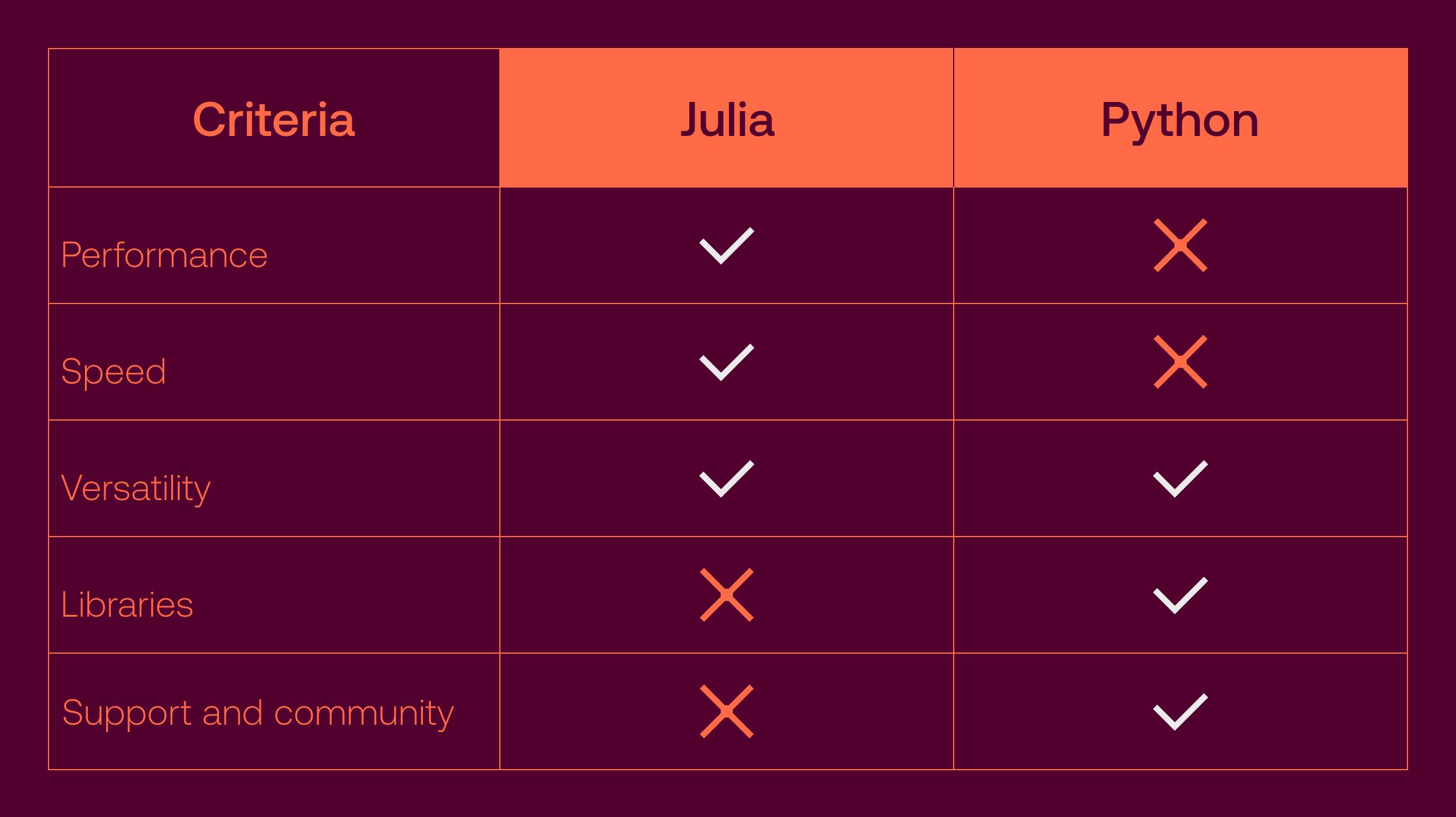
Python or Julia for data science: Which one works best?

In a recent survey of 2,300 data scientists, Python won nearly 66% of the votes as the top analytics, data science, and machine learning tool. Organizations such as Google, NASA, CERN, Spotify, and Facebook use Python for many tasks including complex data science chores. Given that Python was introduced 30 years ago, its widespread and continued use is a testimony to the language’s solid design and logic.
Python supports multiple programming paradigms, such as object-oriented programming, structured programming, functional programming patterns, and more. Python can handle data mining, website application scripting, scientific computing, and running embedded systems, all in one unified language.
In 2012, developers introduced Julia. Their goal was to create a language that would be as usable as Python, have the same computational capabilities as Matlab, and be as fast as C.
As a general-purpose language, Julia can write any application, however, it's especially at home working with numerical analysis and computational science.
Which one, Julia vs. Python, is better for data science? Let's dig into the details.
Python for data science: Benefits and business value
Simplicity and tons of free libraries
Python isn't considered to be inherently strong in statistical analysis, however, it's straightforward design and simplicity make it easy to learn and use. Plus, there are any number of free Python dedicated analytical libraries out there so data scientists can easily find the right out of the box package.
Easy to build out and integrate
Python's extensibility and all purpose reach make it hugely popular. For this reason, many organizations standardize on it, and this extends into data science. "We like to stay in the Python ecosystem," said Burc Arpat, a quantitative engineering manager at Facebook. "We have a lot of systems inside Facebook, or infrastructure that allows us to either use Python to talk to those systems or integrates with Python very easily or is written in Python."
Low startup overhead
As most programmers are familiar with the language, applying Python to data science is easy. Plus, the free libraries reduce costs. This usability frees engineers to quickly drill into problem solving without having to evaluate and test competing function libraries. Also, getting new talent up to speed is faster as many coders know Python like the back of their hand.
Helpful community assistance
Additionally, the massive Python open-source community is known for being both lively and helpful making it a rich source of information and guidance.
Julia for data science: Benefits and business value
General purpose, high performance
The Julia coding language provides for general purpose, high-level dynamic programming designed to be especially effective for numerical and scientific computing. For faster runtime, Julia is just-in-time (JIT) compiled using the LLVM compiler framework. At its best, Julia can approach or match the performance of statically-compiled languages like C/C++.
Light and efficient
Feather light and efficient, Julia doesn’t need huge compute power to run a relatively complex script. Even lightweight computers can use Julia to perform computationally intensive operations in real-time. This optimizes compute resource use significantly.
Scales fast
Julia can scale fast and wide even in the absence of a big data framework. By adding more system resources and running essential commands on the Julia kernel, scripts scale up in a straight-forward manner.
Julia is friendly
Julia integrates well with many popular programming languages. You can easily call C, Python, and R scripts through Julia. Through easy integration, Julia facilitates data science methodology. Also, Julia is a high-level language which makes it easy to understand even for non-experts.
Python vs. Julia: Which is better for data science?

Performance
Julia performance matches that of C and Fortran which are low-level languages that are hard to write code in. However, it’s easy to create a prototype in Julia. As a result, Julia sidesteps the problem where you use one language (e.g. Python, R, etc.) to create a proof of concept and another language (e.g. C++ or Java) to implement the POC in production. Julia does it all by itself.
Performance Winner: Julia.
Speed
JIT compilation and type declarations make Julia significantly faster than pure, unoptimized Python. You can juice up Python via external libraries, third-party JIT compilers (PyPy), and optimizations tools (e.g. Cython), but this adds work. Stripped down, head to head, Julia is much, much faster. Still, Python is getting up to speed. For instance, the mypyc project translates type-annotated Python into native C.
Speed Winner: Julia
Versatility
Both languages are designed for highly versatile, general purpose code. However, Julia was especially built for scientific computing and data processing. Python can handle data mining, website scripting, scientific computing, and it can run back-end messaging systems which is how Spotify uses it. While Python might be more versatile overall, for data processing they’re both great.
Versatility Winner: Tie
Libraries
By sheer age alone, Python has a vast array of libraries. A recent estimate placed the total number of Python libraries at around 137,000. Not all of these apply to data science, however, for nearly any data science task, you can find a Python analytical library that fits. Julia also has a rapidly growing library list, but it's still just too young to compete.
Libraries Winner: Python
Support & community
Towering over the competition, the Python community is immense and extremely helpful. The Julia community is growing fast though. Since the 2012 launch, Julia has been downloaded by users at more than 10,000 companies with over 20,000,000 downloads as of September 2020. Both languages have robust support and a friendly, engaged community. Still, the sheer size and maturity of Python give it the edge.
Support & Community Winner: Python
Which one's better? Python or Julia?
It's hard to say definitively which language is better as it all depends on your specific needs. For example, if performance and speed are your highest priorities, then Julia might be your best bet. If you need to expand your engineering team rapidly, the well-known standard Python might enable you to get your talent working faster. Plus, if you already have a lot of Python script up and running, you might choose to use the same language for data science and stay consolidated.
Either way, both Python and Julia are incredible tools that are sure to meet the needs and expectations of any data scientist.





